8 Wild And Domesticated Species That You May Have Trouble Telling Apart
People have bred domesticated animals throughout history to encourage specific traits. Domestic animals are chosen for their calm demeanor and ability to procreate in confinement. Their capacity to withstand sickness and thrive in harsh environments is also significant. Over time, these traits began to distinguish domesticated animals from their wild ancestors visually. However, some domesticated species have not undergone significant changes in their visual characteristics, and many people may easily confuse a wild specimen with a domesticated one. These are 8 examples of domesticated species refusing to deviate from their ancestral looks.
Almost 400 domestic dog breeds have been developed as a result of centuries of affection and selective breeding of dogs. The origins of dogs and their particular affinity with humans are still being researched. A widespread theory is that the bond between humans and dogs was formed when our ancestors started sharing food with gray wolves, which then became their pets and assisted them in hunting.
The serval weighs 29 pounds, which is nearly three times the weight of the ordinary domestic cat, according to the shelter. It is thought to be approximately five years old, or one-fourth of its average lifespan.
Almost 200 kinds of domestic sheep exist, ranging from types that generate excessive amounts of wool and require regular shearing to avoid overheating to tropical variations with smooth coats comparable to goats. Despite the sheep's reputation for being docile and easy to manage, several kinds have demonstrated exceptional intelligence, including the capacity to know their own names.
There are now approximately 200 different breeds of domestic goats. From small miniatures maintained as house pets to cashmere goats with smooth coats used for textiles to huge animals weighing up to 300 pounds, there is something for everyone.
The once-ferocious wild boar has been tamed into over 70 domestic pig breeds, ranging from pink pigs to big, hairy varieties adapted to certain habitats. Pigs, against popular belief, are very clever creatures. Recent medical breakthroughs indicate that they might potentially be used to generate fresh hearts for transplantation.
African cattle descended from the older line and were subsequently interbred with the indicus type, which is distinguished by its unique hump and provides superior adaption to hotter temperatures. There are about 800 recognized cow breeds, however, only a tiny number of them are recognized by breed associations. The global cattle population is projected to be 1.5 billion people.
Today's horse has over 200 recognized breeds, as well as hundreds of unique local types that are not recognized by breeding organizations. A European food processing business mislabeled horse meat as beef in 2013, resulting in many recalls of goods containing the meat.
If you enjoyed reading this article, please consider pressing Like and sharing it. Follow our website for more animal news like it.
1. Regular vs wild dogs
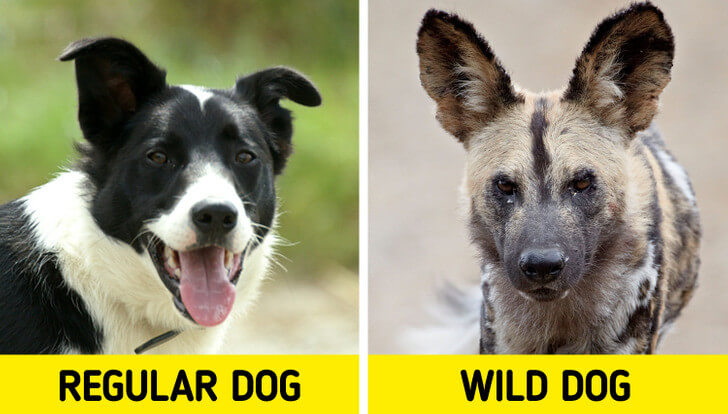 Source: © Ken Billingto, © robertharding
Source: © Ken Billingto, © robertharding
Almost 400 domestic dog breeds have been developed as a result of centuries of affection and selective breeding of dogs. The origins of dogs and their particular affinity with humans are still being researched. A widespread theory is that the bond between humans and dogs was formed when our ancestors started sharing food with gray wolves, which then became their pets and assisted them in hunting.
2. Regular vs wild cats
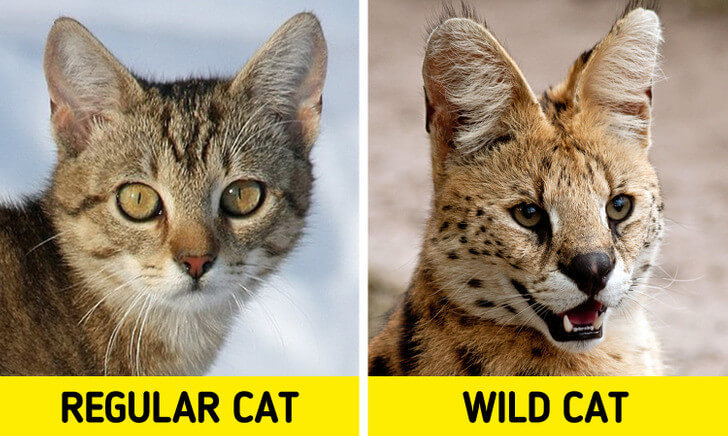 Source: © Von.grzanka, © RooM the Agency
Source: © Von.grzanka, © RooM the Agency
The serval weighs 29 pounds, which is nearly three times the weight of the ordinary domestic cat, according to the shelter. It is thought to be approximately five years old, or one-fourth of its average lifespan.
3. Regular vs wild sheep
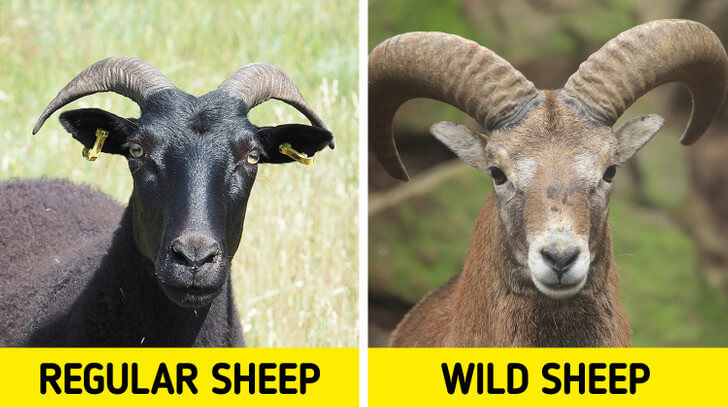 Source: © Bernard Ladenthin, © WoodsAndrew
Source: © Bernard Ladenthin, © WoodsAndrew
Almost 200 kinds of domestic sheep exist, ranging from types that generate excessive amounts of wool and require regular shearing to avoid overheating to tropical variations with smooth coats comparable to goats. Despite the sheep's reputation for being docile and easy to manage, several kinds have demonstrated exceptional intelligence, including the capacity to know their own names.
4. Regular vs wild goats
 Source: © George Chernilevsky, © Alexander Malkhasyan
Source: © George Chernilevsky, © Alexander Malkhasyan
There are now approximately 200 different breeds of domestic goats. From small miniatures maintained as house pets to cashmere goats with smooth coats used for textiles to huge animals weighing up to 300 pounds, there is something for everyone.
5. Regular vs wild pigs
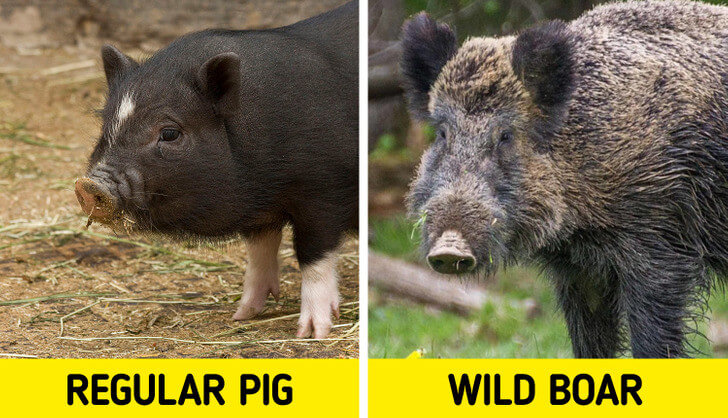 Source: © Johan Spaedtke, © Valentin Panzirsch
Source: © Johan Spaedtke, © Valentin Panzirsch
The once-ferocious wild boar has been tamed into over 70 domestic pig breeds, ranging from pink pigs to big, hairy varieties adapted to certain habitats. Pigs, against popular belief, are very clever creatures. Recent medical breakthroughs indicate that they might potentially be used to generate fresh hearts for transplantation.
6. Regular vs wild cows
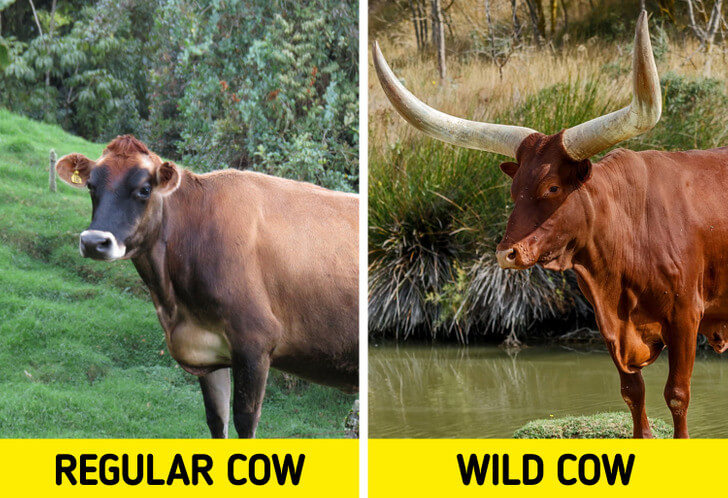 Source: © Luis Manuel Madrigal, © H. Zell
Source: © Luis Manuel Madrigal, © H. Zell
African cattle descended from the older line and were subsequently interbred with the indicus type, which is distinguished by its unique hump and provides superior adaption to hotter temperatures. There are about 800 recognized cow breeds, however, only a tiny number of them are recognized by breed associations. The global cattle population is projected to be 1.5 billion people.
7. Regular vs wild goldfish
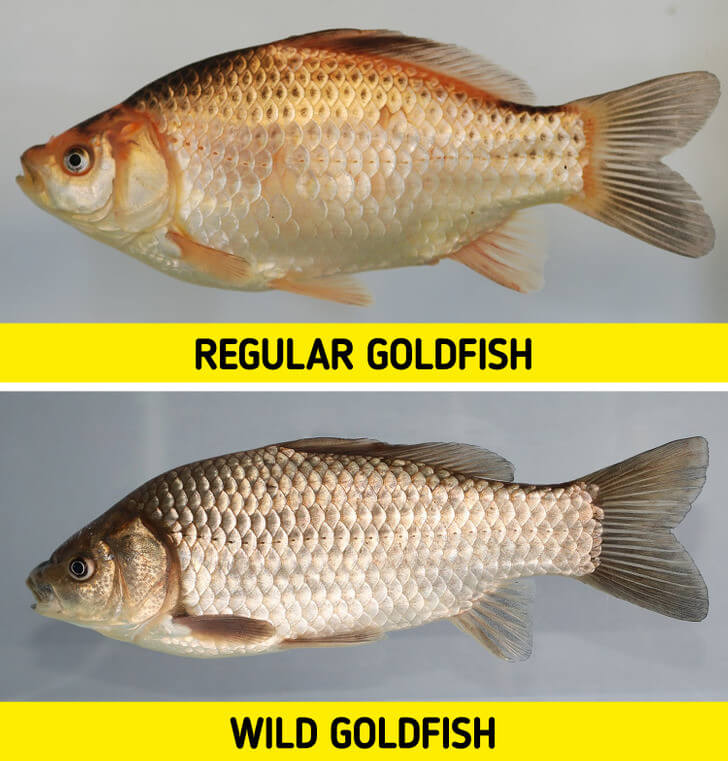 Source: © Smithsonian Environmental Research Center, © George Chernilevsky
Source: © Smithsonian Environmental Research Center, © George Chernilevsky
It was once thought that goldfish were descended from the Crucian carp, but current research has indicated that they are either descended from the closely related Prussian carp or the consequence of hybridization. Wild goldfish, unlike their domesticated cousins, has a subdued color palette of metallic greens rather than brilliant oranges and whites. Selective breeding of mutant goldfish began some 2000 years ago in China. Goldfish ponds became prominent landscape features in China during the Tang Dynasty.
Despite the sad habit of giving goldfish away as carnival prizes, which has resulted in the deaths of many of these pets, goldfish are also a common food source for captive carnivorous fish. Goldfish may live for over a decade if properly cared for, however many die prematurely.
8. Regular vs wild horses
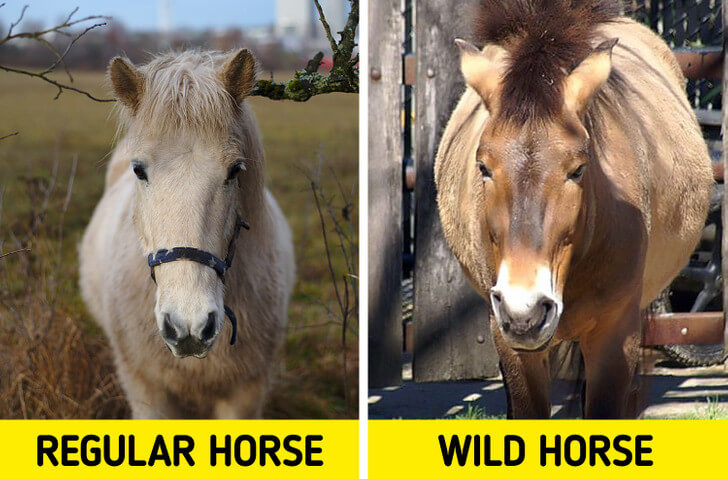 Source: © Flocci Nivis, © Photo by David J. Stang
Source: © Flocci Nivis, © Photo by David J. Stang
Today's horse has over 200 recognized breeds, as well as hundreds of unique local types that are not recognized by breeding organizations. A European food processing business mislabeled horse meat as beef in 2013, resulting in many recalls of goods containing the meat.
If you enjoyed reading this article, please consider pressing Like and sharing it. Follow our website for more animal news like it.
Share this article
Advertisement